Minolta Vest
The Minolta Vest (ミノルタ・ヴェスト) or Minolta Best (ミノルタ・ベスト) is a collapsible camera taking both 4×6.5cm and 3×4cm exposures on 127 film, made by Molta (the predecessor of Minolta) and distributed by Asanuma Shōkai from 1934 to the early 1940s.
Contents
Description
 
|
| Bakelite sliding boxes, collapsed and extended. (Image rights) |
The body of the Minolta Vest is made of bakelite, reinforced with bits of tissue and wire.[1] The lens and shutter assembly is mounted on a front plate, itself attached to a collapsible structure consisting of three rectangular sliding boxes. These boxes are made of the same plastic as the rest of the body, externally reinforced with metal parts. It is said that the whole concept of a bakelite camera with "bakelite bellows" was imagined by Ehira Nobujirō, who worked for Molta before founding his own Ehira company.[2] The same system was later used on the Minolta Six 6×6 camera. It seems that the motivation for these bakelite bellows was the shortage of natural leather caused by the war-like situation in East Asia.[3]
The front plate is kept in closed position by a metal spring attached to the top plate and is pulled out by two small handles. The standing leg retracts behind the front plate and the serial number is engraved on its back.
 
|
| Half-frame exposure mask, attached and detached. (Image rights) |
There is a folding frame finder in the middle of the top plate, with indications for both 4×6.5 and 3×4 formats. A mask must be inserted in the exposure chamber to take 3×4cm pictures. The back is hinged to the left and contains two uncovered red windows to control film advance, one in the middle and the other at the left end.

|
| Camera's back. (Image rights) |
The name Minolta is embossed in the front leatherette. The back leatherette is embossed with a hexagonal strip and an MTS logo, whose shape differs depending on the version.
The shutter is an everset Marble giving T, B, 25, 50, 100 speeds on all the versions and the shutter plate is always inscribed MARBLE, but there are differences of detail as described below. The release lever is always attached to the front of the shutter housing.
The dimensions are 14×8×5cm and the weight is 375g, for the earliest version with f/8 lens and metal advance knob.[4]
Name and release date

|

|

|
| (Image rights) |
Most sources say that the Minolta Vest was released in 1934; this release year is already mentioned in an official chronology published in 1958,[5] and has been repeated ever since. [6] Attempts have been made at a more precise dating: Minolta's fifty-year history specifies January 1934,[7] but other sources say November.[8] The earliest advertisement observed so far is in Asahi Camera April 1935, but earlier documents might exist.[9] Various websites have said that the Minolta Vest was the first camera to bear the Minolta name. However, it was preceded by the Minolta strut-folding camera, inspired by the Plaubel Makina.
Today, the camera is usually called by three different names: "Minolta Vest", "Minolta Best" and "Minolta Marble". Only the latter is plainly wrong: this is a confusion with the name of the shutter, prominently written on the shutter plate. The company originally used both the names Minolta Vest and Minolta Best. In Japan at the time, 127 film was thought of as "Vest film" because of the Vest Pocket Kodak, but usually pronounced with a "b" and written ベスト・フィルム (besuto firumu) in katakana.[10] Meanwhile, an elementary understanding of English was widespread and the English word "best" would have been understood; "Best" may well have also reminded people of the Bessa, well known and highly regarded at the time.
The name Minolta Vest is found in advertisements and catalogues, written ミノルタ・ヴェスト (minoruta vesuto) in katakana or "Minolta-Vest" in Roman script.[11] The form ミノルタ・ベスト (minoruta besuto) in katakana appears in other advertisements, but it can be used for either "best" or "vest".[12] The name "Minolta Best" in Roman writing has been observed on a variant of the leather case, providing evidence that the company used both names.
Evolution
Early version, f/8 lens only

|
| Minolta Vest no.5788, f/8 lens, early shutter plate, flat metal knob. Picture courtesy of eBayer hbpartner. (Image rights) |
 
|
| Close-up attachment, mounted and detached. (Image rights) |
The Minolta Vest was first released with a fixed-focus f/8 lens. The early model has a specific shutter plate design, with both circular and diagonal metal stripes. The speed settings are engraved on the shutter plate itself and the name MARBLE is engraved immediately below. There is an MTS logo on the right and the aperture scale is at the bottom, with 8, 11, 16, 22 settings in metal over a black background. The round MTS logo is repeated on the leatherette covering of the back.
The f/8 lens is fixed-focus and the camera was sold with a close-up attachment that can be screwed into the lens rim. The lens has no marking; its focal length is 75mm and it was made by Asahi Kōgaku.[13] Original advertising documents say that the lens has four elements, and the leaflets reproduced below specifically describe a cemented doublet on the rear, corrected by another "meniscus lens" at the front, certainly corresponding to an Aplanat construction — nonetheless classified as a "simple lens" (単玉, tangyoku).[14] Some sources distinguish between an Aplanat 75/8 and a Coronar 75/8 and others say that the lens was called Coronar Anastigmat, but these are certainly mistaken.[15]
  
|
| Metal advance knob, flat and threaded type. On the right picture, the two-stage threaded knob protrudes from the camera case. (Image rights) |
 
|
| Pulling handle: flatter and round. (Image rights) |
The advance knob is made of metal and situated at the bottom right, as seen by a photographer holding the camera horizontally. Three variants of this advance knob are known. One of them is very high and has a hollow top.[16] Another is thin and has a flat top with a small offset screw.[17] The late type of advance knob is thin and has a hollow top with a screw thread to attach a higher knob, probably to make film winding easier while the camera is in its leather case.[18]
The two handles used to pull out the front plate present minor variations: most cameras have round handles, whereas the camera pictured in this article and very few others have a flatter handle shape,[19] also visible in the leaflet reproduced immediately below.
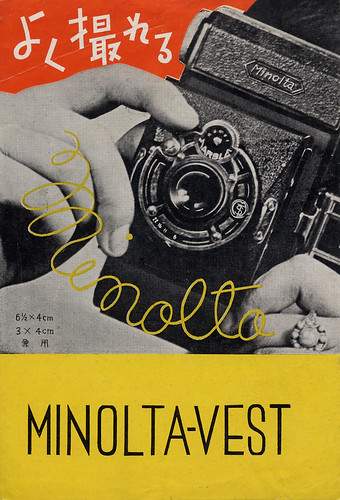
|
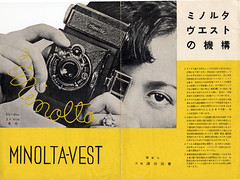
|
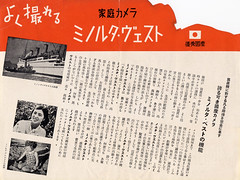
| |
| Leaflet for the Minolta Vest dating c.1934–5, presenting the early f/8 model.[20] Scans courtesy of A. Apra. (Image rights) | |
The early model is offered for ¥19.50 in advertisements and leaflets dated April 1935 and later.[21] It still appears in an advertisement dated July 1936, where it is listed at an unchanged price, together with the newer f/5.6 version.[22]
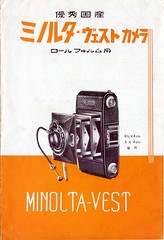 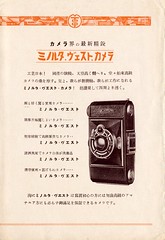 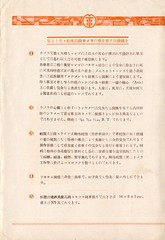 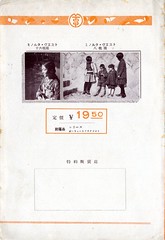
|
| Leaflet for the Minolta Vest dating c.1934–5, presenting the early f/8 model.[23] Scans courtesy of A. Apra. Click on the image for a translation. (Image rights) |
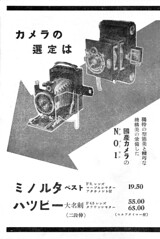
|
| Early Minolta Vest f/8 in an advertisement dated 1935. Scan by A. Apra. (Image rights) |
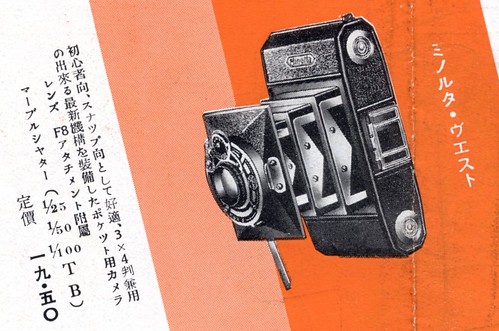
|
| Minolta Vest, early f/8 model. Extract from a leaflet dating c.1935.[24] Scan courtesy of A. Apra. Click on the image for a translation. (Image rights) |
New shutter face, f/8 and f/5.6 versions
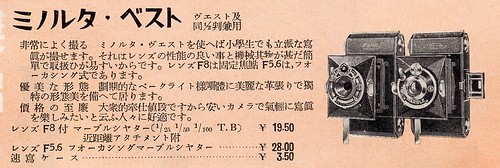
|
| Minolta Vest, early f/8 model on the left, new f/5.6 model on the right, from a leaflet dating c.1936.[25] Scan courtesy of A. Apra. Click on the image for a translation. (Image rights) |
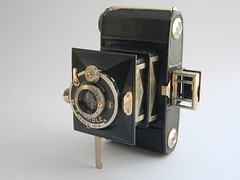 
|
| Left: Minolta Vest no.18289, f/5.6 lens, metal knob. Right: Minolta Vest no.34898, f/8 lens, late shutter plate, threaded metal knob. Pictures courtesy of eBayer hbpartner. (Image rights) |
A new model with a front-cell focusing f/5.6 lens was introduced in late 1935 or early 1936. The lens is normally engraved Coronar Anastigmat Nippon 1:5.6 f=75mm with a serial number.[26] It was certainly made by Asahi Kōgaku, like the 75mm Coronar lenses of the Semi Minolta, and the serial numbers probably run in the same sequence.[27] The lens rim is chrome and there is a cylindrical infinity stop. The distance scale goes from 1m to 7m and infinity, and the aperture scale has 5.6 and 6.3 to 25 settings in the old aperture system. There is a red dot on the distance scale and on the aperture scale, for hyperfocal setting.

|

|
| Scheme and description of the Coronar lens. Click on the image for a translation. (Image rights) |
This f/5.6 model has a new shutter plate, black with a silver rim. It is marked PATENTS NIPPON at the top and MARBLE at the bottom with the MTS logo on the right. The aperture scale is at the bottom, with the settings written in black over the silver background. The speed dial is different too, and has a thicker shape. The earliest cameras might have a cylindrical wheel rotating around a small plate shaped as an arrow and acting as an index. This has been observed on an isolated example with a low lens number[28] and seemingly appears on the leaflet dating c.1936 reproduced in this page. The regular model has a conical speed wheel, moving behind a circular disc with an index at the top.
 
|
| MTS logo in back leatherette, round and rectangular type. (Image rights) |
The f/5.6 model certainly exists with the threaded advance knob only. The back leatherette is embossed with a rectangular MTS logo instead of the round logo of the early f/8 version.
The f/5.6 model was already listed in an advertisement dated January 1936.[29] An advertisement dated July 1936 lists this model for ¥28 and pictures it side by side with the early f/8 version.[30]
The new shutter plate, conical speed wheel and newer back logo introduced for the f/5.6 model were later applied to the f/8 model too. This newer version is pictured in the advertisement in Asahi Camera April 1937.[31]
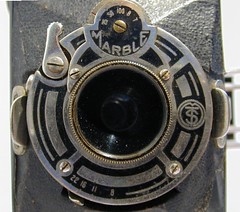 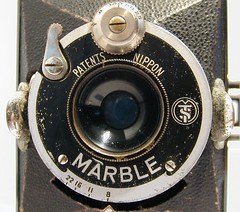
|
| Old and new shutter plate of the f/8 model. (Image rights) |
Introduction of the f/4.5 model
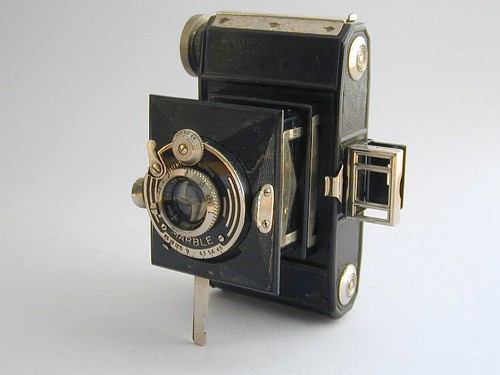
|
| Minolta Vest no.23250, f/4.5 lens, metal knob. Picture courtesy of eBayer hbpartner. (Image rights) |
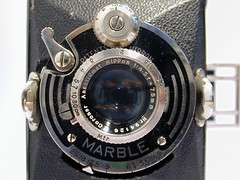
|
| Shutter plate of the f/4.5 model. (Image rights) |
A third model with front-cell focusing f/4.5 lens was introduced in mid-1937.[32] The lens is the same as on the Semi Minolta (I) and II, engraved Coronar Anastigmat Nippon 1:4.5 f=75mm with a serial number. The shutter plate is very similar to the f/5.6 model but it normally has three metal stripes on both sides of the lens. The infinity stop is the same but there is no red dot for hyperfocal distance, and the distance scale goes from 1m to 30m and infinity. The aperture scale has 4.5, 5.6 and 6.3 to 25 settings in the old system.

|
| Minolta Vest in the July 1938 catalogue and price list by Asanuma Shōkai. Scans by A. Apra. (Image rights) |
One isolated example with f/4.5 lens is pictured in Sugiyama with a shutter plate exactly similar to the f/5.6 model, without the metal stripes.[33] It seems that its aperture scale has 4.5 to 22 settings in the new system, but this is barely legible.
The advertisement in Asahi Camera August 1937 lists the f/8, f/5.6 and f/4.5 models for ¥19.50, ¥28 and ¥35 respectively.[34] Advertisements in the same magazine dated October 1937 and January 1938 give higher prices of ¥21, ¥32 and ¥38 respectively, certainly because of the additional excise tax levied after the outbreak of war with China;[35] the same prices are found in the July 1938 catalogue by Asanuma Shōkai.[36] The same models still appear in the advertisement in Asahi Camera October 1939, for prices reportedly going from ¥23 to ¥41.[37]
Bakelite knob
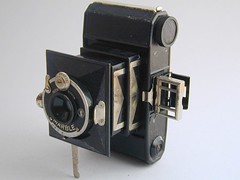 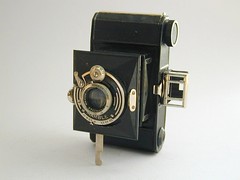
|

|

| ||

|

| |||
| Left picture: Minolta Vest no.49684, f/8 lens, bakelite knob. Right picture and thumbnails: Minolta Vest no.50613, f/4.5 lens, bakelite knob. Pictures courtesy of eBayer hbpartner. (Image rights) |
||||

|
| Bakelite advance knob. (Image rights) |
The Minolta Vest was modified at some time with a bakelite advance knob situated at the top right. The other film flanges at the top left and at the bottom were also switched to bakelite, only the centre part of the tripod thread remaining in metal. The metal knob still appeared in an advertisement dated December 1939[38] and the change occurred after that date and before October 1941 (see below).
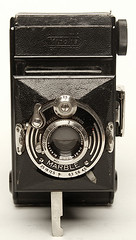 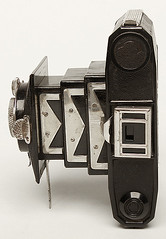
|
| Minolta Vest, f/4.5 lens, bakelite knob. Pictures by Rick Soloway. (Image rights) |
The bakelite knob exists on all three versions. However the only f/5.6 example with a bakelite knob observed so far is pictured in Francesch.[39] It has some part reinforcing the bakelite top plate and supporting the frame finder in an offset position as well as an accessory shoe. This is certainly the result of a repair of a broken plastic body.
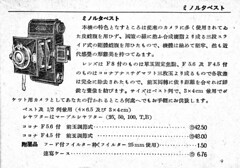
|
| Extract of the October 1941 catalogue by Asanuma Shōkai. Click on the image for a translation. (Image rights) |
The Minolta Vest appears in the official price list compiled in October 1940 and published in January 1941, under the names "Minolta Vest I" (ミノルタヴェストⅠ, ¥23) and "Minolta Vest II" (ミノルタヴェストⅡ, ¥41), probably corresponding to the f/8 and f/5.6 or f/4.5 models respectively.[40]
The October 1941 catalogue by Asanuma Shōkai is illustrated by a drawing of the camera with a bakelite knob, and uses the name "Minolta Best" (ミノルタベスト).[41] It mentions the three models but only gives the price with f/5.6 lens (¥42.50) and with f/4.5 lens (¥48).
The f/8 version of the Minolta Vest is listed again in the April 1943 government inquiry on camera production, under the name "Minolta Best I" (ミノルタベストⅠ).[42] This is the last known mention of the camera.
Case and accessories
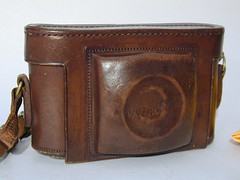 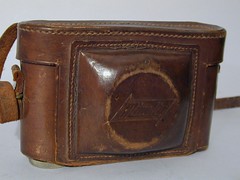
|
| Examples of case for the Minolta Vest. Pictures courtesy of eBayer hbpartner. (Image rights) |
The case was sold for ¥4.60 in July 1938 and ¥6.76 in October 1941.[43] Several types are known; all are embossed Minolta in various ways, and at least one is embossed Minolta BEST.
Hoods with filter holders were sold as an accesory for ¥1.50.[44] Two sizes exist: 24.5mm for the f/8 model and 26.5mm for the f/5.6 and f/4.5 models; they all take 25mm diameter filters.[45]
Production estimate
After 1936, the Minolta Vest was produced in the Amagasaki (尼崎) plant, founded as the subsidiary Nihon Kōgaku Kikai Kenkyūjo, and later merged into the main Molta, then Chiyoda company.[46] It is said that its total production was about 30,000 examples;[47] however this figure might be underestimated.[48] Serial numbers have been observed from 4464 to 50613, but the data is sparse and it is not known if the numbers ran in a single sequence or not.
Notes
- ↑ Leaflet Yoku toreru Minolta: Minolta-Vest: 母体及蛇腹の原料は特殊の布片及ワイヤーを混合した高級フェノール樹脂であります. The document does not use the colloquial word "bakelite" (ベークライト) but its scientific equivalent "phenolic resin" (フェノール樹脂). Tanimura, p.32 of Kurashikku Kamera Senka no.51, mentions "bakelite reinforced with bits of tissue". Lewis, p.50, Baird, p.38, and The Japanese Historical Camera simply say "bakelite". McKeown, p.673, says that it was some sort of plastic "in the experimental stage in Germany".
- ↑ Concept imagined by Ehira Nobujirō: Tanimura, p.32 of Kurashikku Kamera Senka no.51.
- ↑ Kikan Classic Camera 14, p.15.
- ↑ Leaflets Yoku toreru Minolta: Minolta-Vest, and Yūshū kokusan Minoruta Vesuto kamera rōrufirumu-yō.
- ↑ "Hensen kamera ichiran-pyō", p.295 of Shashin Kōgyō no.77, reproduced in this Flickr page by Rebollo_fr.
- ↑ Francesch, pp.21 and 76, Kokusan kamera no rekishi, p.470, Sugiyama, pp.27–8, Scheibel, p.19, McKeown, p.673, Tanimura, p.1 of Camera Collectors' News no.116, Awano, p.16 of Kurashikku Kamera Senka no.12.
- ↑ Minolta 50-nen no ayumi, pp.5 and 65.
- ↑ The Japanese Historical Camera, p.20, and this page of the Center of the History of Japanese Industrial Technology.
- ↑ Advertisement reproduced in Tanimura, p.11 of Camera Collectors' News no.118. In Kokusan kamera no rekishi, p.342, the list of advertisements starts with that in Asahi Camera November 1935, reportedly mentioning the camera as "newly released" (新発売); this list is certainly incomplete, something very unusual for this document.
- ↑ Japanese does not distinguish between /v/ and /b/ sounds, and so the /v/ sound of English, French, etc. and words written with "v" are often pronounced and written as /b/ within Japanese. For some recent loanwords and foreign names originally pronounced [v] (a "labiodental" sound, i.e. one made with upper lip and lower teeth), some Japanese speakers use a "bilabial" (i.e. lips-only) sound, [β]. While its articulation differs from English [v], its sound will strike most nonspecialists as very similar; outside phonetics contexts, it is normally taken as "v".
- ↑ The Roman form "Minolta-Vest" (with an hyphen) appears in the leaflet Yūshū kokusan Minoruta Vesuto kamera rōrufirumu-yō reproduced in this page.
- ↑ The names of other contemporary cameras were written ベスト (besuto) in Japanese but "Vest" in Roman writing, as on the Vest Alex (ベスト・アレックス) and Vest Olympic (ベスト・オリンピック).
- ↑ Focal length and attribution to Asahi Kōgaku: "Kokusan shashinki no genjōchōsa" (国産写真機ノ現状調査, Inquiry into Japanese cameras), listing Japanese camera production as of April 1943. Reproduced in Supuringu kamera de ikou: Zen 69 kishu no shōkai to tsukaikata (スプリングカメラでいこう: 全69機種の紹介と使い方, Let's try spring cameras: Presentation and use of 69 machines). Tokyo: Shashinkogyo Syuppan-sha, 2004. ISBN 4-87956-072-3. Pp.180–7., lens item Ld3, where it is described as a "simple lens" (単玉).
- ↑ Leaflets Yoku toreru Minolta: Minolta-Vest and Yūshū kokusan Minoruta Vesuto kamera rōrufirumu-yō: 色収差は二枚の異質レンズのバルサム接合により完全に除去され更に可及的彎曲匡正の為め其の前方にメニスカス・レンズを置き[...]即ち単玉と申し乍ら四枚のレンズが[...]完全なる焦点を結びます. The mention of a "cemented four-element lens" (合計四枚Xレンズ where "X" stands for an illegible character) is also found in the July 1935 advertisement in Toki no Nagare (a publication of Asanuma Shōkai), reproduced in Tanimura, p.9 of Camera Collectors' News no.116.
- ↑ Distinction between Aplanat and Coronar: Francesch, p.76. — Coronar Anastigmat: McKeown, p.673, Eimukku 735 Minolta, p.133. The use of the Coronar name (a triplet lens design) is very unlikely.
- ↑ Examples pictured in Lewis, p.50, in Scheibel, p.19, in Eimukku 735 Minolta, p.133, in Kikan Classic Camera 14, p.15, in the 70th anniversary poster reproduced in Photoclub Alpha and in other websites copying the same picture.
- ↑ Example pictured in this article and example observed in an online auction.
- ↑ The early model is pictured with this advance knob in Baird, p.41, and McKeown, p.673.
- ↑ Flatter handle type: examples pictured in this article and in Sugiyama, item 1191.
- ↑ Yoku toreru Minolta: Minolta-Vest.
- ↑ Advertisement in Asahi Camera April 1935 reproduced in Tanimura, p.11 of Camera Collectors' News no.118; advertisement on the second cover of Nihon Shashin Kōgyō Tsūshin June 1st, 1935, reproduced on p.18 of Hyaku-gō goto jūkai no kiroku, giving the price as ¥19, perhaps by mistake; advertisement in Asahi Camera July 1935 reproduced in Kokusan kamera no rekishi, p.83; advertisement in Toki no Nagare July 1935 (a publication of Asanuma Shōkai) reproduced in Tanimura, p.9 of Camera Collectors' News no.116. See also the leaflets reproduced in this page: Yūshū kokusan Minoruta Vesuto kamera rōrufirumu-yō (dated c.1934–5) and Asanuma Shōkai hatsubai no kokusan kamera Minoruta Happī (dated c.1935).
- ↑ Advertisement in Toki no Nagare July 1936 (a publication of Asanuma Shōkai), reproduced in Tanimura, p.9 of Camera Collectors' News no.116. See also the leaflet Danzen kesshutsu shita kokusan kamera dating c.1936, reproduced in this page.
- ↑ Yūshū kokusan Minoruta Vesuto kamera rōrufirumu-yō.
- ↑ Asanuma Shōkai hatsubai no kokusan kamera Minoruta Happī.
- ↑ Danzen kesshutsu shita kokusan kamera.
- ↑ At least one example of the Minolta Vest is reported with an 80mm f/5.6. This lens is probably not original and was maybe swapped with that of a Minolta Six.
- ↑ Coronar lenses made by Asahi Kōgaku: "Kokusan shashinki no genjōchōsa" ("Inquiry into Japanese cameras"), lens items Lb5 and Lc9 (for the Semi Minolta). This is also found in Sugiyama, p.27, and in Lewis, p.182.
- ↑ Example observed in an online auction, lens number in the 4xxx range.
- ↑ Advertisement published in Ars Camera, reproduced in Kokusan kamera no rekishi, p.96.
- ↑ Advertisement inserted in Toki no Nagare (a publication of Asanuma Shōkai), reproduced in Tanimura, p.9 of Camera Collectors' News no.116. Another advertisement dated July 1936, published in Shashin Shinpō and showing the f/5.6 version, is reproduced in Hagiya, p.10 of Kurashikku Kamera Senka no.12.
- ↑ Advertisement reproduced in Kokusan kamera no rekishi, p.98.
- ↑ Kokusan kamera no rekishi, p.342, says that this version appears in the advertisements from September 1937, but the advertisement in Asahi Camera August 1937 reproduced on p.97 of the same source already lists the f/4.5 lens option.
- ↑ Sugiyama, item 1188.
- ↑ Advertisement reproduced in Kokusan kamera no rekishi, p.97.
- ↑ Advertisement in Asahi Camera October 1937 reproduced in Kokusan kamera no rekishi, p.98; advertisement in Asahi Camera January 1938 reproduced in Tanimura, p.15 of Camera Collectors' News no.118. Additional tax: see Japanese prices.
- ↑ July 1938 catalogue by Asanuma Shōkai, p.1, and corresponding price list, p.1.
- ↑ Advertisement reproduced in this page of the Heiki Seikatsu website. The prices are not legible in the reproduction but they are reported in the web page.
- ↑ Advertisement published in Shōgakusei no Kagaku, formerly reproduced in the Gochamaze website (archived).
- ↑ Francesch, p.77.
- ↑ "Kokusan shashinki no kōtei kakaku", type 2, sections 2 and 4.
- ↑ October 1941 catalogue by Asanuma Shōkai, p.9.
- ↑ "Kokusan shashinki no genjōchōsa" ("Inquiry into Japanese cameras"), item 181. The camera is mistakenly registered as made of steel.
- ↑ July 1938 price list by Asanuma Shōkai, p.1, and October 1941 catalogue by Asanuma Shōkai, p.9.
- ↑ July 1938 price list by Asanuma Shōkai, p.1, and October 1941 catalogue by Asanuma Shōkai, p.9.
- ↑ Sizes: July 1938 price list by Asanuma Shōkai, p.1.
- ↑ Awano, p.7 of Kurashikku Kamera Senka no.12.
- ↑ Awano, pp.7 and 16 of Kurashikku Kamera Senka no.12; Tanimura, p.33 of Kurashikku Kamera Senka no.51.
- ↑ Awano, p.16 of Kurashikku Kamera Senka no.12, reports that 50,000 Baby Minolta and 30,000 Minolta Vest were made, but says that these figures might be inverted.
Bibliography
Original documents
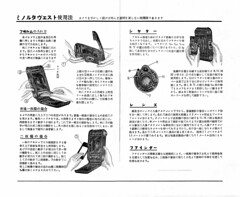
|
| User manual for the Minolta Vest (f/8, early). Scan courtesy of A. Apra. (Image rights) |
- Asanuma Shōkai. Shashinki to zairyō (写真機と材料, Cameras and supplies). Catalogue dated October 1941. Pp.7 and 9. Document partly reproduced in this Flickr album by Rebollo_fr.
- Fujii Yoshinari (藤井由成). Tsūzoku Shashin-jutsu (通俗写真術, Popular photography technique). Ōsaka Shashin Shinbunsha (大阪写真新聞社), 1935. (Contains an advertisement for the Happy.)
- "Kokusan shashinki no genjōchōsa" (国産写真機ノ現状調査, Inquiry into Japanese cameras), listing Japanese camera production as of April 1943. Reproduced in Supuringu kamera de ikou: Zen 69 kishu no shōkai to tsukaikata (スプリングカメラでいこう: 全69機種の紹介と使い方, Let's try spring cameras: Presentation and use of 69 machines). Tokyo: Shashinkogyo Syuppan-sha, 2004. ISBN 4-87956-072-3. Pp.180–7. Item 181.
- "Kokusan shashinki no kōtei kakaku" (国産写真機の公定価格, Set prices of the Japanese cameras), listing Japanese camera production as of October 25, 1940 and setting the retail prices from December 10, 1940. Published in Asahi Camera January 1941 and reproduced in Shōwa 10—40nen kōkoku ni miru kokusan kamera no rekishi (昭和10〜40年広告にみる国産カメラの歴史, Japanese camera history as seen in advertisements, 1935—1965). Tokyo: Asahi Shinbunsha, 1994. ISBN 4-02-330312-7. Pp.108—9. Type 2, sections 2 and 4.
- Leaflet for the Minolta Vest, dating c.1934–5, by Asanuma Shōkai. Yoku toreru Minolta: Minolta-Vest (よく撮れるMinolta: Minolta-Vest, Good picture-taking Minolta: the Minolta-Vest). Document owned by A. Apra and reproduced in this Flickr album by Rebollo_fr.
- Leaflet for the Minolta Vest, dating c.1934–5, perhaps by Molta. Yūshū kokusan Minoruta Vesuto kamera rōrufirumu-yō (優秀国産ミノルタ・ヴェストカメラロールフィルム用, Excellent Japan-made Minolta Vest camera, for rollfilm). Document owned by A. Apra and reproduced in this Flickr album by Rebollo_fr.
- Leaflet for the Minolta and Happy range, dating c.1935, certainly by Asanuma Shōkai. Asanuma Shōkai hatsubai no kokusan kamera Minoruta Happī (浅沼商会発売の国産カメラミノルタ・ハッピー, Japan-made Minolta and Happy cameras distributed by Asanuma Shōkai). Document owned by A. Apra and reproduced in this Flickr album by Rebollo_fr.
- Leaflet for the Minolta and Happy range and King accessories, dating c.1936, certainly by Asanuma Shōkai. Danzen kesshutsu shita kokusan kamera (断然傑出した国産カメラ, Definitely excellent Japan-made cameras). Document owned by A. Apra and reproduced in this Flickr album by Rebollo_fr.
- Manual of the Minolta Vest, dating c.1934. Minoruta Vesuto shiyōhō (ミノルタヴェスト使用法, Minolta Vest user manual). Document owned by A. Apra and reproduced in this Flickr album by Rebollo_fr.
- Nihon Shashin Kōgyō Tsūshin (日本写真興業通信). Hyaku-gō goto jūkai no kiroku (百号ごと十回の記録, Ten records, every hundred issues). Tokyo: Nihon Shashin Kōgyō Tsūshin Sha (日本写真興業通信社), 1967. No ISBN number. Advertisement on p.18, corresponding to the second cover of the June 1st, 1935 issue.
Official historical accounts
- Minolta Camera. Minolta 50-nen no ayumi (Minolta・50年のあゆみ, Minolta 50-year history). November 1978. Pp.5 and 65.
- Shashin Kōgyō no.77 (September 1958). "Hensen kamera ichiran-pyō" (変遷カメラ一らん表, Table of camera evolution.) P.295. (This is a chronology of Minolta cameras from the Nifcarette onwards. This document is reproduced in this Flickr page by Rebollo_fr.)
- Taniguchi Masao (谷口匡男), from the commercial department (営業部) of Chiyoda Kōgaku Seikō. "Minoruta kamera no sakujitsu, konnichi" (ミノルタ・カメラの昨日、今日, Minolta cameras, yesterday and today). In Shashin Kōgyō no.77 (September 1958). Pp.275–9. (The two first pages of this document, on pre-1937 cameras, are also reproduced in Tanimura, p.8 of Camera Collectors' News no.116.)
Recent sources
- Asahi Camera (アサヒカメラ) editorial staff. Shōwa 10–40nen kōkoku ni miru kokusan kamera no rekishi (昭和10–40年広告にみる国産カメラの歴史, Japanese camera history as seen in advertisements, 1935–1965). Tokyo: Asahi Shinbunsha, 1994. ISBN 4-02-330312-7. Item 276. (See also the advertisements for items 179, 272 and 277 and the text and pictures on pp.10 and 423–4.)
- Awano Mikio (粟野幹男). "Minoruta ryakushi" (ミノルタ略史, Minolta short history). Kamera Rebyū: Kurashikku Kamera Senka (カメラレビュー クラシックカメラ専科) / Camera Review: All about Historical Cameras no.12, October 1988. No ISBN number. Minoruta kamera no subete (ミノルタカメラのすべて, special issue on Minolta). Pp.6–8.
- Awano Mikio (粟野幹男). "Senzen no Minoruta kamera" (戦前のミノルタカメラ, Prewar Minolta cameras). Kamera Rebyū: Kurashikku Kamera Senka (カメラレビュー クラシックカメラ専科) / Camera Review: All about Historical Cameras no.12, October 1988. No ISBN number. Minoruta kamera no subete (ミノルタカメラのすべて, special issue on Minolta). Pp.13–7.
- Baird, John R. The Japanese Camera. Yakima, WA: Historical Camera Publications, 1990. ISBN 1-879561-02-6. Pp.38 and 41.
- Eimukku 735, Manyuaru Kamera Shirīzu 15 (エイムック735・マニュアルカメラシリーズ15). Minolta: Minoruta kamera no subete (Minolta:ミノルタカメラのすべて, Minolta: all of Minolta cameras). Tokyo: Ei Shuppansha, 2003. ISBN 4-87099-923-4. "Jabara-shiki kamera no kiseki" (蛇腹式カメラの軌跡", Evolution of folding cameras). Pp.130–1 and 133. (See also the pictures on the front cover and on p.4.) Gives a brief summary of the Minolta Vest and shows a few pictures.
- Francesch, Dominique and Jean-Paul. Histoire de l'appareil photographique Minolta de 1929 à 1985. Paris: Dessain et Tolra, 1985. ISBN 2-249-27685-4. Pp.21–2 and 76–7.
- Hagiya Takeshi (萩谷剛). "Kōkoku ni miru Minoruta kamera no rekishi" (広告に見るミノルタカメラの歴史, Minolta camera history seen through the advertisements). Kamera Rebyū: Kurashikku Kamera Senka (カメラレビュー クラシックカメラ専科) / Camera Review: All about Historical Cameras no.12, October 1988. No ISBN number. Minoruta kamera no subete (ミノルタカメラのすべて, special issue on Minolta). Pp.9–12.
- The Japanese Historical Camera. 日本の歴史的カメラ (Nihon no rekishiteki kamera). 2nd ed. Tokyo: JCII Camera Museum, 2004. P.20.
- Kikan Classic Camera 14 Tokushū: Minoruta Rokkōru densetsu (季刊クラシックカメラ14・特集ミノルタロッコール伝説, special: Minolta Rokkor legend). Tokyo: Futabasha, 2002. ISBN 4-575-47427-4. P.15. (This special issue on Minolta mainly treats postwar SLR cameras, and has little information on the Minolta Vest.)
- Lewis, Gordon, ed. The History of the Japanese Camera. Rochester, N.Y.: George Eastman House, International Museum of Photography & Film, 1991. ISBN 0-935398-17-1 (paper), 0-935398-16-3 (hard). Pp.50 and 182.
- McKeown, James M. and Joan C. McKeown's Price Guide to Antique and Classic Cameras, 12th Edition, 2005-2006. USA, Centennial Photo Service, 2004. ISBN 0-931838-40-1 (hardcover). ISBN 0-931838-41-X (softcover). P.673.
- Saeki Kakugorō (佐伯恪五郎). "Tashima Gizō-shi ni kiku" (田嶋義三氏に聞く, Asking Tashima Gizō). Kamera Rebyū: Kurashikku Kamera Senka (カメラレビュー クラシックカメラ専科) / Camera Review: All about Historical Cameras no.12, October 1988. No ISBN number. Minoruta kamera no subete (ミノルタカメラのすべて, special issue on Minolta). Pp.76–9.
- Scheibel, Anni Rita and Joseph. 70 Jahre Minolta Kameratechnik — Von der Nifcalette bis zur Dynax 9. Stuttgart: Lindemanns Verlag, 3rd edition, 1999. ISBN 3-89506-191-3. Pp.18–9.
- Sugiyama, Kōichi (杉山浩一); Naoi, Hiroaki (直井浩明); Bullock, John R. The Collector's Guide to Japanese Cameras. 国産カメラ図鑑 (Kokusan kamera zukan). Tokyo: Asahi Sonorama, 1985. ISBN 4-257-03187-5. Items 1188–92.
- Tanimura Yoshihiko (谷村吉彦). "Ehira Nobujirō no kamera: Ehira Kōki, Uehā kara Eruchina made" (江平信次郎のカメラ・江平光機、ウエハーからエルチナまで, The cameras of Ehira Nobujirō, from the Weha to the Eltina). Kamera Rebyū: Kurashikku Kamera Senka (カメラレビュー クラシックカメラ専科) / Camera Review: All about Historical Cameras no.51, June 1999. ISBN 4-257-13024-5. Kurashikku kamera supesharu (クラシックカメラスペシャル, issue about miscellaneous classic cameras). Pp.32–9. (Mentions the Minolta Vest as a creation of Ehira Nobujirō.)
- Tanimura Yoshihiko (谷村吉彦). "Supuringu kamera <semi minoruta>" (スプリングカメラ<セミミノルタ>, 'Semi Minolta' self-erecting camera). Kamera Rebyū: Kurashikku Kamera Senka (カメラレビュー クラシックカメラ専科) / Camera Review: All about Historical Cameras no.12, October 1988. No ISBN number. Minoruta kamera no subete (ミノルタカメラのすべて, special issue on Minolta). Pp.19–24. (Contains a reproduction of an advertisement showing the Minolta Vest.)
- Tanimura Yoshihiko (谷村吉彦). "Semi Minoruta I-gata to II-gata." (セミミノルタⅠ型とⅡ型, Semi Minolta I and II) In Camera Collectors' News no.116 (February 1987). Nishinomiya: Camera Collectors News-sha. (Contains a reproduction of the articles in Shashin Kōgyō no.77, discusses the release date and contains a reproduction of an advertisement showing the Minolta Vest.)
- Tanimura Yoshihiko (谷村吉彦). "Semi Minoruta I-gata to II-gata (sono 2)." (セミミノルタⅠ型とⅡ型(その2), Semi Minolta I and II (part 2)) In Camera Collectors' News no.118 (April 1987). Nishinomiya: Camera Collectors News-sha. (Contains reproductions of advertisements showing the Minolta Vest.)
- Zaisu Ikon (座椅子遺恨, probably a pseudonym of Y. Saji). "Besuto sanka (M–O)" (ベスト讃歌[M–O], Vest hymn [M–O]). In Camera Collectors' News no.63 (September 1982). Nishinomiya: Camera Collectors News-sha. P.4. (Gives a brief description and pictures of two cameras; one of these is presumably the same as Sugiyama's item 1190.)
- Zaisu Ikon (座椅子遺恨, probably a pseudonym of Y. Saji). "Besuto sanka (hoi 3)" (ベスト讃歌[補遺3], Vest hymn [appendix 3]). In Camera Collectors' News no.99 (September 1985). Nishinomiya: Camera Collectors News-sha. P.6.
Links
General links
In English:
- Minolta Vest (f/8, early) in the 70th anniversary Minolta poster, reproduced at Photoclub Alpha
In Japanese:
- Minolta Vest (f/8, early) in the Camera database of the Center of the History of Japanese Industrial Technology
- Minolta Vest (f/8, medium) in the first page of the Yamada Camera Museum
- Minolta Vest (f/5.6, medium) repair notes at Kan's Room
- Minolta Vest (f/5.6, medium) at the AJCC
- Minolta Vest (f/5.6, medium) at Itō Sadanobu's camera collection (archived)
- Minolta Vest (f/4.5, medium) in Ranzōsha's camera pages
- Minolta Vest (f/4.5, late) among A-Z 127 film cameras at Asacame
Original documents
In Japanese:
- Advertisement for the Minolta Vest published in the October 1939 issue of Asahi Camera, reproduced in this page of the Heiki Seikatsu website. It is the fourth advertisement from the top.
| Nifca, Molta and Chiyoda prewar and wartime cameras () | |
|---|---|
| folding plate cameras | |
| Nifcaklapp | Nifcasport | Sirius | Arcadia | Lomax | Eaton | Happy | |
| folding rollfilm cameras | telescopic bakelite cameras |
| Nifcarette | Sirius Bebe | Semi Minolta | Auto Semi Minolta | Minolta Vest | Baby Minolta | Minolta Six |
| strut-folding cameras | TLR cameras |
| Nifca-Dox | Minolta | Auto Minolta | Auto Press Minolta | Minoltaflex | Minoltaflex Automat | Minoltaflex military prototype |
| Minolta Classic Cameras |
|---|
| Vest (or Best) | V2 | SR-2 | SRT 101 | XE | XD | CLE | 7000 | 9000 | 800 si |